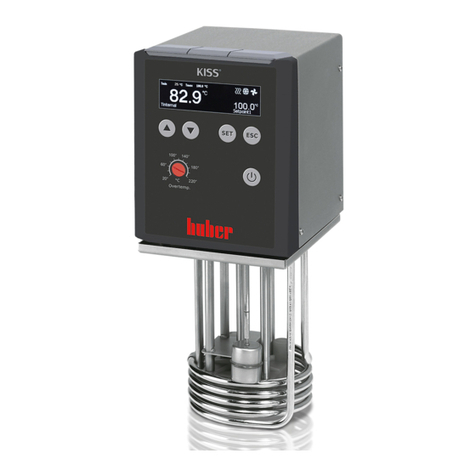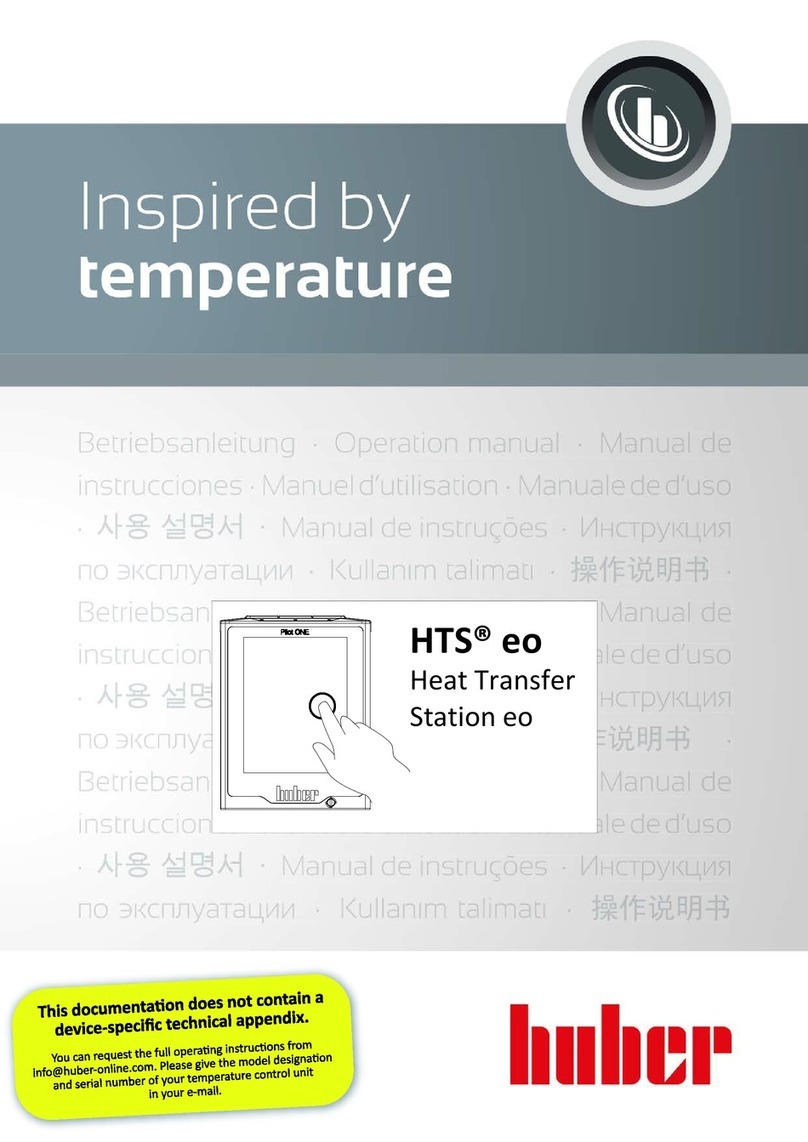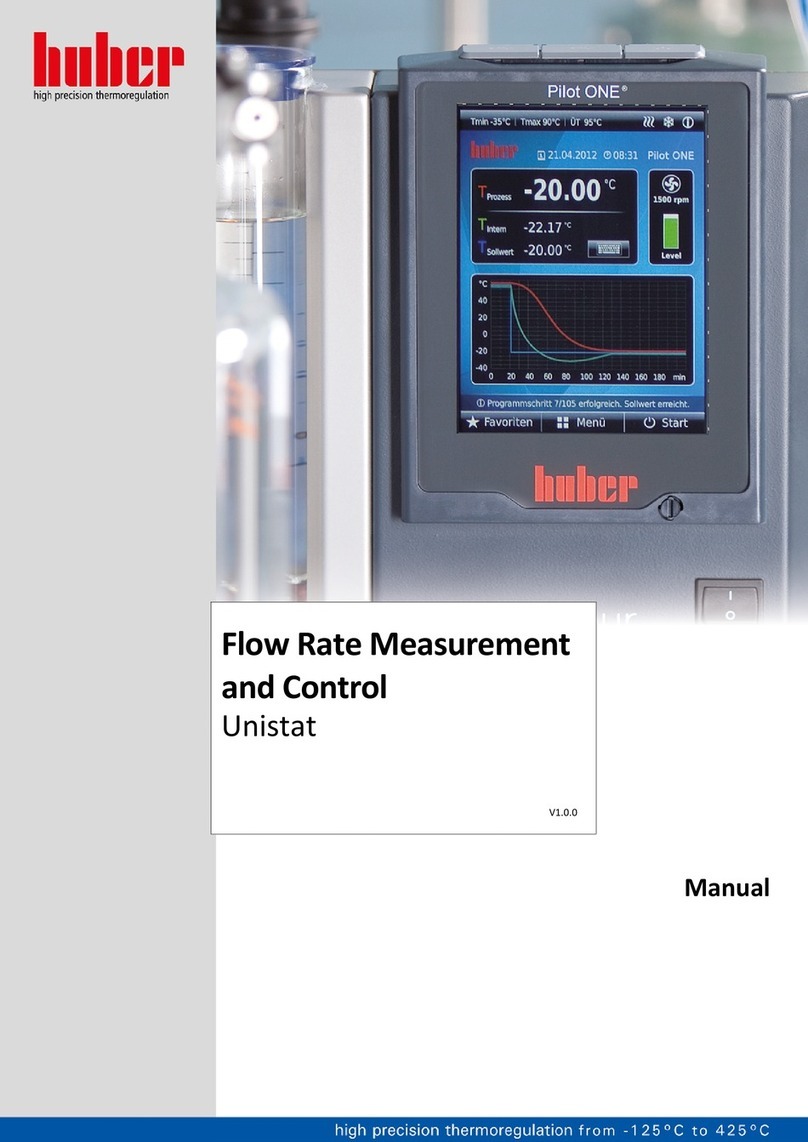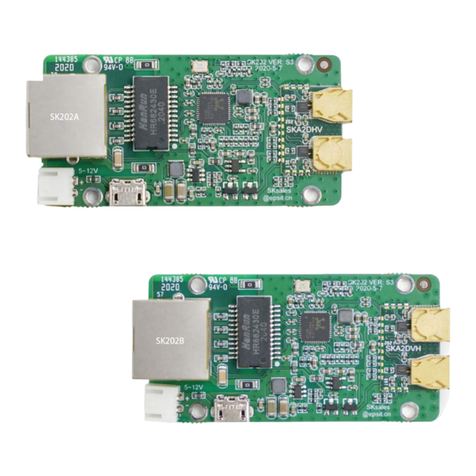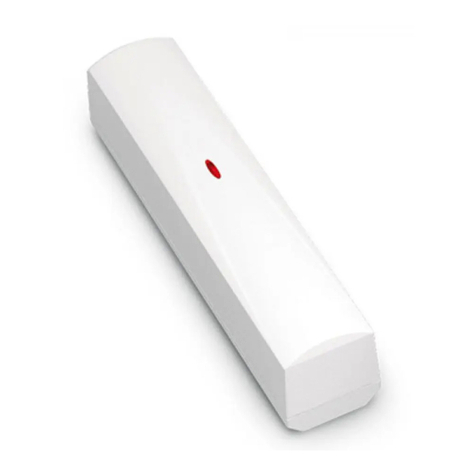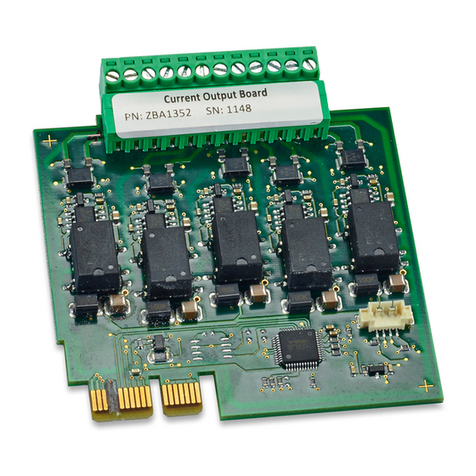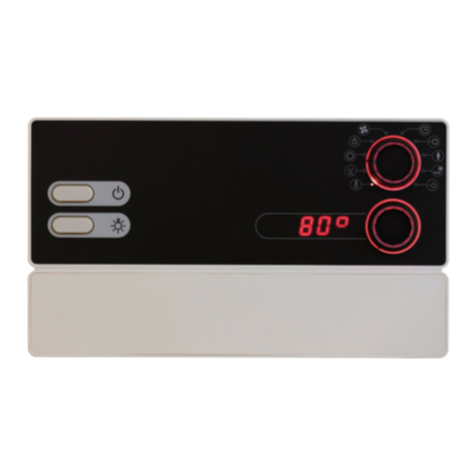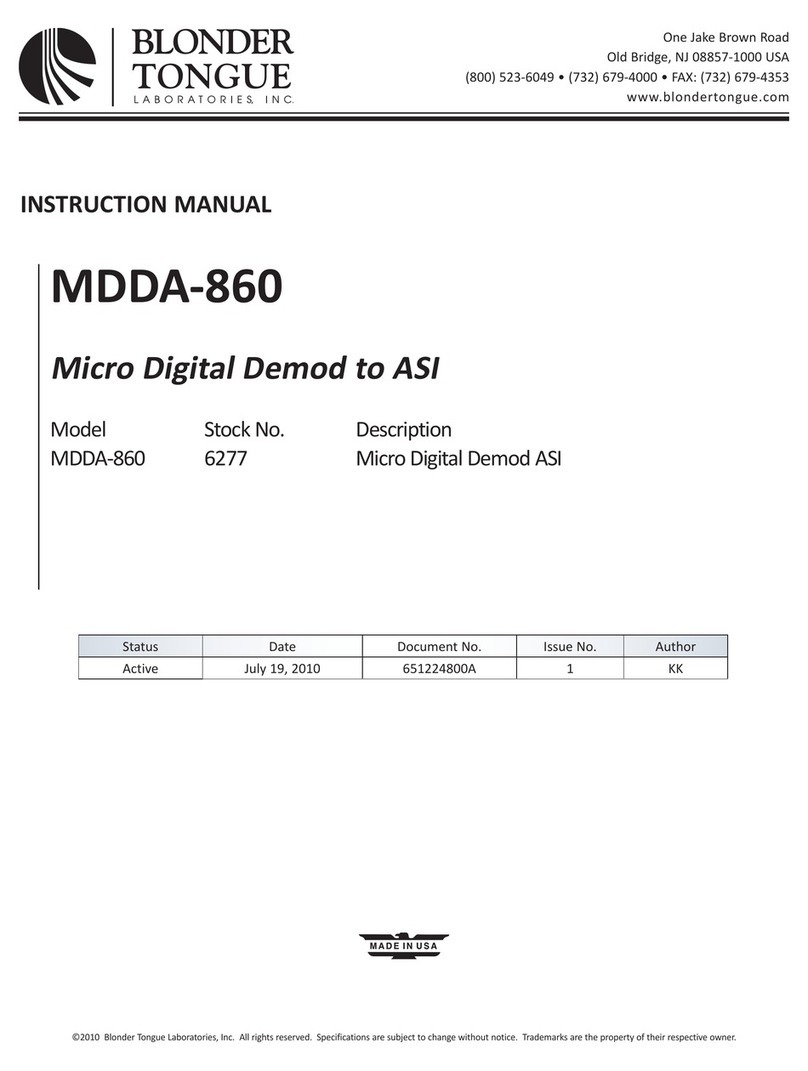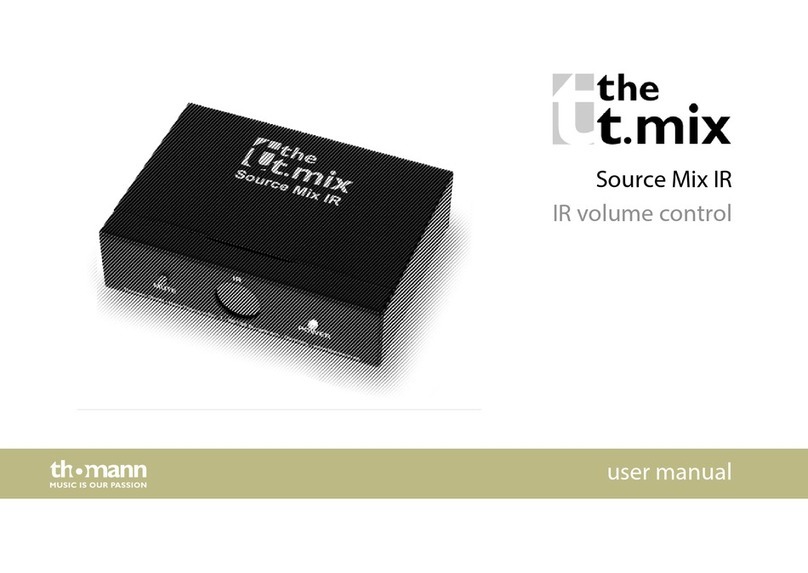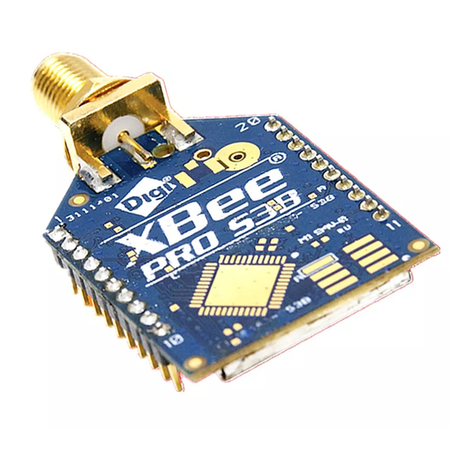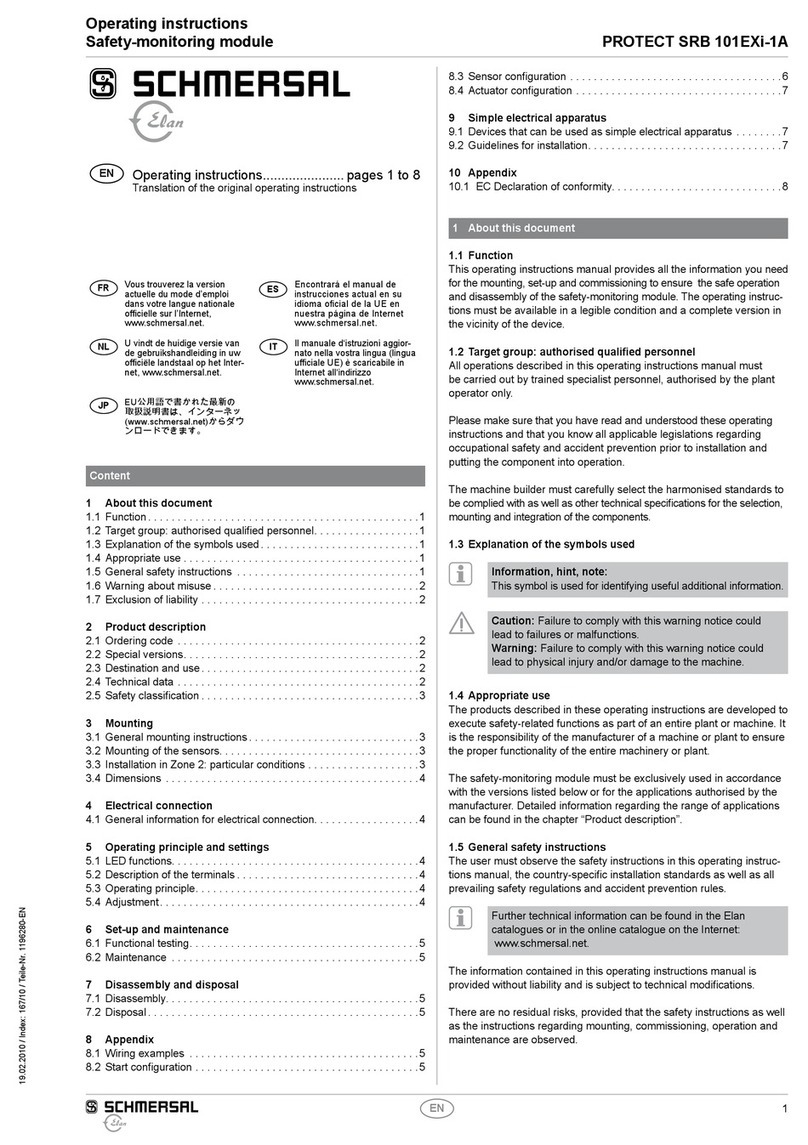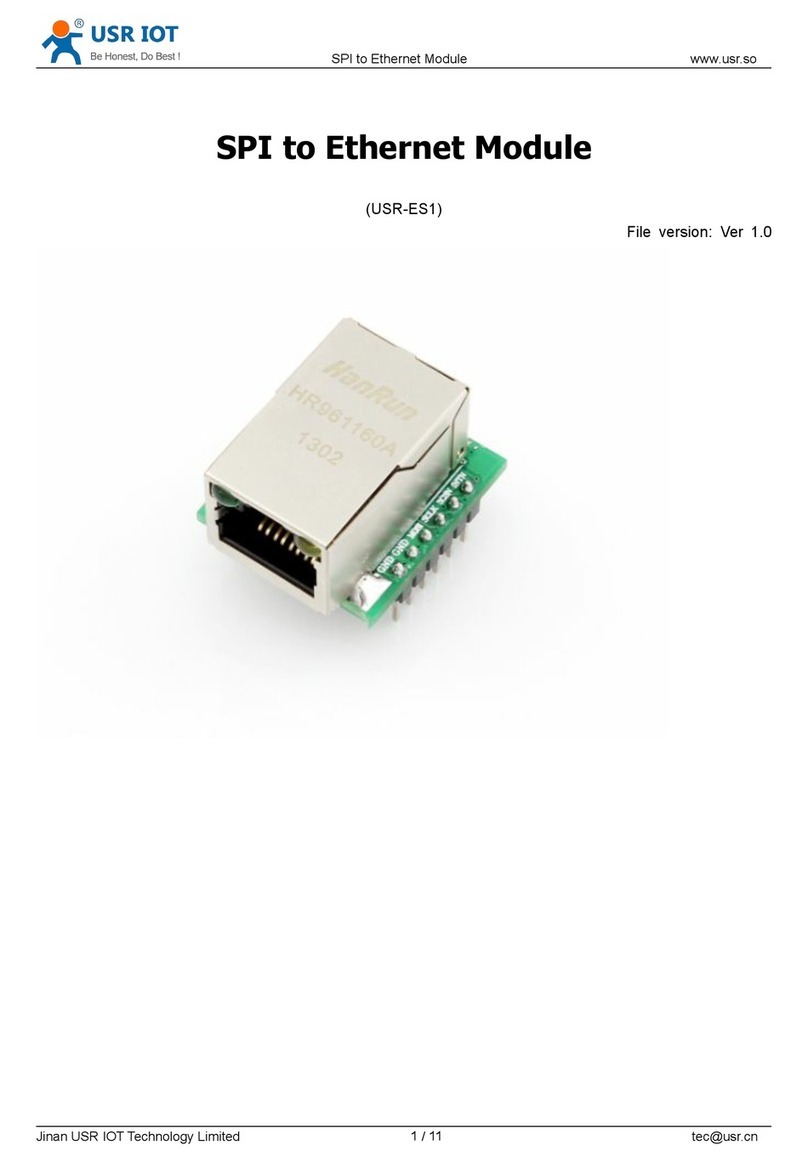Huber Pilot ONE Unistat T305 User manual

Unistat®
T300 Series


OPERATION MANUAL
Unistat®
T300 Series


OPERATION MANUAL
V2.4.0en/22.07.20//17.12 Unistat® T300 Series
5
Unistat®
T300 Series
Pilot ONE®
This operation manual is a translation of the original operation manual.
VALID FOR:
TABLE-TOP MODELS
Unistat® T305
Unistat® T32x
FREE-STANDING MODELS
Unistat® T33x
Unistat® T34x
Unistat® T35x
Abbreviations used in model names:
HT = with HT air cooling, w HT = with HT water cooling

OPERATION MANUAL
Unistat® T300 Series V2.4.0en/22.07.20//17.12
6
“Unistat Control ONE“
and „Pilot ONE“
Description of the
LEDs in the flow dia-
gram
Components illustrat-
ed in the
LED flow diagram

OPERATION MANUAL
V2.4.0en/22.07.20//17.12 Unistat® T300 Series
7
Layout of the “Home”
screen

OPERATION MANUAL
Unistat® T300 Series V2.4.0en/22.07.20//17.12
8
Table of contents
V2.4.0en/22.07.20//17.12
1Introduction 14
1.1 Details on the declaration of conformity....................................................... 14
1.2 Safety .......................................................................................................... 14
1.2.1 Symbols used for Safety Instructions..............................................................14
1.2.2 Representation of safety identifiers ...............................................................15
1.2.3 Proper operation.............................................................................................15
1.2.4 Reasonably foreseeable misuse......................................................................16
1.3 Responsible bodies and operators – Obligations and requirements............... 16
1.3.1 Obligations of the responsible body ...............................................................16
1.3.1.1 Proper disposal of resources and consumables .........................................17
1.3.2 Requirements for operators ...........................................................................17
1.3.3 Obligations of the operators...........................................................................17
1.4 General information..................................................................................... 17
1.4.1 Description of workstation .............................................................................17
1.4.2 Safety devices to DIN 12876 ...........................................................................18
1.4.3 Further protective devices ..............................................................................19
1.4.3.1 Power interruption.....................................................................................19
1.4.3.2 Alarm functions ..........................................................................................19
1.4.3.3 Warning messages......................................................................................19
1.5 Exemplary illustrations of the cooling variants.............................................. 20
1.5.1 Consequence of inadequate energy dissipation.............................................20
2Commissioning 22
2.1 In-plant transport......................................................................................... 22
2.1.1 Lifting and transporting the temperature control unit...................................22
2.1.1.1 Temperature control unit with lifting eyes ................................................22
2.1.1.2 Temperature control unit without lifting eyes...........................................23
2.1.2 Mounting/removing leveling feet...................................................................23
2.1.3 Positioning the temperature control unit.......................................................24
2.1.3.1 Temperature control unit with casters ......................................................24
2.1.3.2 Temperature control unit without casters.................................................24
2.2 Transportation lock ...................................................................................... 24
2.2.1 Transportation lock Type A.............................................................................25
2.2.1.1 Releasing the transportation lock (operating position)..............................25
2.2.1.2 Tightening the transportation lock (transport position) ............................25
2.2.2 Transportation lock Type B .............................................................................25
2.2.2.1 Releasing the transportation lock (operating position)..............................25
2.2.2.2 Tightening the transportation lock (transport position) ............................25
2.2.3 Transportation lock Type C .............................................................................26
2.2.3.1 Releasing transportation lock Type C .........................................................26
2.2.3.2 Tightening transportation lock Type C .......................................................26
2.3 Unpacking.................................................................................................... 26
2.4 Ambient conditions...................................................................................... 26
2.4.1 EMC-specific notes..........................................................................................28
2.5 Installation conditions.................................................................................. 28
2.6 Recommended temperature control and cooling water hoses ...................... 29
2.7 Wrench sizes and torques............................................................................. 29

OPERATION MANUAL
V2.4.0en/22.07.20//17.12 Unistat® T300 Series
9
2.8 Temperature control units with water cooling.............................................. 30
2.9 Temperature control unit for outdoor installation incl. winter operation ...... 31
2.10 Preparations for operation ........................................................................... 32
2.10.1 Unscrewing/activating the leveling feet (if any) .............................................32
2.10.2 Opening/closing valves ...................................................................................33
2.10.3 Locking/unlocking the expansion vessel [18]..................................................33
2.10.3.1 Isolating sleeve ...........................................................................................33
2.10.3.2 Shut-off valves............................................................................................34
2.11 Connecting an externally closed/open application........................................ 35
2.11.1 Connecting an externally closed application ..................................................35
2.11.2 Connecting an externally open application (bath)..........................................35
2.12 Connecting to the power supply ................................................................... 36
2.12.1 Connection using socket with protective earth (PE).......................................36
2.12.2 Connection via hard wiring .............................................................................36
2.12.3 Converting the power supply connection.......................................................37
2.12.4 Connecting the functional earth.....................................................................37
3Function description 38
3.1 Function description of the temperature control unit ................................... 38
3.1.1 General functions............................................................................................38
3.1.2 Other functions...............................................................................................38
3.2 Information on the thermal fluids ................................................................ 39
3.3 To be noted when planning the test ............................................................. 40
3.4 “Pilot ONE®” controller ................................................................................ 41
3.4.1 Functional overview of “Pilot ONE®” ..............................................................41
3.5 Unistat® LED diagram ................................................................................... 43
3.6 Clock/event function.................................................................................... 43
3.6.1 Rechargeable accumulator .............................................................................43
3.6.2 Programmable event function ........................................................................44
3.6.2.1 Event function “Alarm clock event” ...........................................................44
3.6.2.2 Event function “Program event” ................................................................44
3.7 Operation via the touch screen..................................................................... 44
3.8 Display instruments ..................................................................................... 44
3.8.1 The touchscreen [88] ......................................................................................45
3.8.2 The LED-Indicator Temperature [90] ..............................................................45
3.8.3 The LED-Indicator Flow Chart [91] ..................................................................45
3.8.4 The LED-Indicator Status [92] .........................................................................45
3.9 Control instruments ..................................................................................... 45
3.9.1 The touchbuttons............................................................................................45
3.9.2 The categories.................................................................................................46
3.9.3 The sub-categories..........................................................................................46
3.9.4 The dialogs ......................................................................................................46
3.10 Function examples ....................................................................................... 46
3.10.1 Display of software version.............................................................................46
3.10.2 Start & Stop.....................................................................................................46
3.10.3 Copying the settings to a data carrier.............................................................47
3.10.3.1 Saving to a USB flash drive .........................................................................47
3.10.3.2 Loading from a USB flash drive...................................................................47
3.10.4 Restore factory settings ..................................................................................48
3.10.4.1 Restore to factory settings without overtemperature protection .............49
3.10.4.2 Restore to factory settings including overtemperature protection ...........49
4Setup mode 51

OPERATION MANUAL
Unistat® T300 Series V2.4.0en/22.07.20//17.12
10
4.1 Setup mode ................................................................................................. 51
4.1.1 Turning on the temperature control unit .......................................................51
4.1.2 Turning off the temperature control unit.......................................................51
4.1.3 Setting the overtemperature protection ........................................................52
4.1.3.1 General information on the overtemperature protection .........................52
4.1.3.2 Setting “OT limit: heating” .........................................................................52
4.1.3.3 Setting “OT expansion vessel”....................................................................53
4.1.3.4 Setting “Process Safety” .............................................................................53
4.1.3.5 Monitoring via “Display OT values”............................................................53
4.1.4 Testing overtemperature protection for functionality ...................................54
4.1.5 Adjusting the Delta T limiter ...........................................................................54
4.1.5.1 Changing the Delta T limiter.......................................................................54
4.2 The temperature control circuit.................................................................... 54
4.2.1 Select temperature control: Internal or process ............................................55
4.2.2 Temperature control to internal temperature ...............................................55
4.2.3 Temperature control to process temperature................................................56
4.2.4 Delta T limiter .................................................................................................56
4.2.5 Monitoring the Pt100 temperature sensors...................................................56
4.2.6 Optimum control parameters for optimum temperature control..................57
4.2.7 Sub-category: “Select auto/expert mode”......................................................57
4.2.8 Sub-category: “Configuration auto” ...............................................................57
4.2.8.1 Sub-category: “Find parameters”...............................................................57
4.2.8.2 Sub-category: “Control Dynamics”.............................................................59
4.2.8.3 Sub-category: “Fluid Properties”................................................................60
4.2.8.4 Sub-category: “Display parameters” ..........................................................61
4.2.9 Sub-category: “Configuration manual”...........................................................62
4.2.9.1 Sub-category: “Change parameters”..........................................................62
4.2.9.2 Sub-category: “Display parameters” ..........................................................63
4.2.9.3 Sub-category: “Control structure”..............................................................63
4.2.10 Sub-category: “Reset parameters” .................................................................63
4.2.11 Sub-category: “Display parameters”...............................................................64
4.2.12 Setting the setpoint thresholds ......................................................................64
4.2.13 Setting the setpoint ........................................................................................65
4.3 Adjusting the cooling capacity ...................................................................... 65
4.3.1 Cooling water connection ...............................................................................66
4.4 Filling, venting, degassing and draining......................................................... 66
4.4.1 Externally closed application ..........................................................................66
4.4.1.1 Filling and venting externally closed application........................................67
4.4.1.2 Degassing externally closed applications ...................................................68
4.4.1.3 Draining externally closed applications......................................................70
4.4.2 Externally open application ............................................................................71
4.4.2.1 Filling and venting externally open application..........................................71
4.4.2.2 Degassing externally open applications .....................................................73
4.4.2.3 Draining externally open applications........................................................73
5Normal operation 75
5.1 Automatic operation .................................................................................... 75
5.1.1 Temperature control.......................................................................................75
5.1.1.1 Starting the temperature control process..................................................75
5.1.1.2 Ending the temperature control process ...................................................75
5.1.2 Temperature control via a created temperature control program ................76
5.1.2.1 Starting the temperature control program ................................................76

OPERATION MANUAL
V2.4.0en/22.07.20//17.12 Unistat® T300 Series
11
5.1.2.2 Ending/cancelling the temperature control program ................................76
6Interfaces and software update 77
6.1 Interfaces at the “Pilot ONE®” controller ...................................................... 77
6.1.1 10/100 Mbps Ethernet for RJ45 network sockets ..........................................77
6.1.2 USB-2.0 interface ............................................................................................77
6.1.2.1 USB-2.0 interface, host...............................................................................78
6.1.2.2 USB-2.0 interface, device ...........................................................................78
6.2 Interfaces at the “Unistat® Control ONE”...................................................... 78
6.2.1 Interfaces at the “Unistat® Control ONE” side................................................78
6.2.1.1 Removing the cover....................................................................................78
6.2.1.2Jack ECS (External Control Signal) standby.................................................78
6.2.1.3 Connector POKO (floating contact) alarm..................................................79
6.2.2 Interfaces at the “Unistat® Control ONE” top side .........................................81
6.2.2.1 Service interface.........................................................................................81
6.2.2.2 Female RS232 Serial (with adapter cable)..................................................81
6.2.2.3 Connection jack for Pt100 process controller sensor.................................81
6.3 Interfaces at the Com.G@te® (optional) ....................................................... 82
6.3.1 Jack LEVEL (Com.G@te® external only) ..........................................................83
6.3.2 Connector POKO (floating contact) alarm ......................................................83
6.3.3 Jack AIF Reg-E-Prog.........................................................................................83
6.3.4 Jack ECS (External Control Signal) standby .....................................................84
6.3.5 Jack RS232/RS485 serial..................................................................................84
6.4 Firmware update.......................................................................................... 84
7Service/maintenance 85
7.1 Messages from the temperature control unit ............................................... 85
7.2 Replacing the “Pilot ONE®” or “Unistat® Control ONE” ................................. 85
7.2.1 Replacing the “Pilot ONE®”.............................................................................85
7.2.2 Replacing the “Unistat® Control ONE”............................................................86
7.3 Maintenance................................................................................................ 86
7.3.1 Function check and visual inspection .............................................................86
7.3.2 Replacing temperature control or coolant hoses ...........................................88
7.3.2.1 Replacing temperature control hoses ........................................................88
7.3.2.2 Replacing coolant hoses .............................................................................88
7.3.3 Clean liquefier fins (air-cooled temperature control unit) .............................88
7.3.4 Clean hat-type strainer (dirt trap) (water-cooled temperature control unit).89
7.3.5 Emptying the drip tray (if present) .................................................................90
7.4 Thermal fluid inspection, replacement and circuit cleaning........................... 91
7.4.1 Thermal fluid inspection .................................................................................91
7.4.2 Thermal fluid replacement .............................................................................91
7.4.2.1 Externally closed application......................................................................91
7.4.2.2 Externally open application........................................................................91
7.4.3 Rinsing the thermal fluid circuit......................................................................92
7.5 Cleaning the surfaces ................................................................................... 93
7.6 Inspect the mechanical seal.......................................................................... 94
7.6.1 With drip tray..................................................................................................94
7.6.2 Without drip tray ............................................................................................94
7.7 Plug contacts................................................................................................ 94
7.8 Decontamination/repairs ............................................................................. 94
8Shutting down 95
8.1 Safety instructions and basic principles ........................................................ 95

OPERATION MANUAL
Unistat® T300 Series V2.4.0en/22.07.20//17.12
12
8.2 Switch-off .................................................................................................... 95
8.3 Draining the cooling water ........................................................................... 96
8.3.1 Draining process .............................................................................................96
8.4 Transportation lock...................................................................................... 96
8.5 Packing ........................................................................................................ 96
8.6 Shipping....................................................................................................... 96
8.7 Disposal ....................................................................................................... 97
8.8 Contact data ................................................................................................ 98
8.8.1 Telephone number: Customer Support ..........................................................98
8.8.2 Telephone number: Sales ...............................................................................98
8.8.3 Email address: Customer Support...................................................................98
8.9 Certificate of Compliance ............................................................................. 98
9Annex 99

OPERATION MANUAL
V2.4.0en/22.07.20//17.12 Unistat® T300 Series
13
Foreword
Dear Customer,
Thank you for choosing a temperature control unit from Peter Huber Kältemaschinenbau AG. You
have made a good choice. Thank you for your trust.
Please read the operation manual carefully before putting the unit into operation. Strictly follow all
notes and safety instructions.
Follow the operation manual with regard to transport, start-up, operation, maintenance, repair,
storage and disposal of the temperature control unit.
We fully warrant the temperature control unit for the specified intended operation.
The models listed on page 5 are referred to in this operation manual as temperature control units
and Peter Huber Kältemaschinenbau AG as Huber company or Huber.
Liability for errors and misprints excluded.
The following trademarks and the Huber logo are registered trademarks of Peter Huber Kältemaschinenbau AG
in Germany and/or other countries worldwide: BFT®, CC®, Chili®, Com.G@te®, Compatible Control®, CoolNet®,
DC®, E-grade®, Grande Fleur®, KISS®, Minichiller®, Ministat®, MP®, MPC®, Peter Huber Minichiller®, Petite Fleur®,
Pilot ONE®, RotaCool®, Rotostat®, SpyControl®, SpyLight®, Tango®, TC®, UC®, Unical®, Unichiller®, Unipump®,
Unistat®, Unistat-Pilot®, Unistat Tango®, Variostat®. The following trademarks are registered in Germany to DWS
Synthesetechnik: DW-Therm®, DW-Therm HT®

Introduction
OPERATION MANUAL Chapter 1
Unistat® T300 Series V2.4.0en/22.07.20//17.12
14
1Introduction
1.1 Details on the declaration of conformity
The equipment complies with the basic health and safety requirements of the European Directives
listed below:
▪Machinery Directive
▪Low Voltage Directive
▪EMC Directive
1.2 Safety
1.2.1 Symbols used for Safety Instructions
Safety instructions are marked by the below combinations of pictograms and signal words. The
signal word describes the classification of the residual risk when disregarding the operation manual.
Denotes an immediate hazardous situation that will result in death or serious injuries.
Denotes a general hazardous situation that may result in death or serious injuries.
Denotes a hazardous situation that can result in injury.
Denotes a situation that can result in property material damage.
Denotes important notes and usable hints.
Notes in conjunction with Ex px cabinets.
The safety information in this operation manual is designed to protect the responsible body, the
operator and the equipment from damage. Safety instructions appear at the beginning of each
chapter and before instructions. First inform yourself about any residual risks due to misuse before
you start an operation.
Safety information and
procedure

Introduction
Chapter 1 OPERATION MANUAL
V2.4.0en/22.07.20//17.12 Unistat® T300 Series
15
1.2.2 Representation of safety identifiers
The following pictograms are used as safety identifiers. The table gives an overview of the safety
identifier used here.
Identifier Description
Mandatory sign
- Observe the instructions
Warning sign
- General warning sign
- observe the instructions
- Warning of electrical voltage
- Warning of hot surface
- Warning of flammable substances
1.2.3 Proper operation
Operating the temperature control unit in a potentially explosive area
DEATH THROUGH EXPLOSION
Do NOT install or start up the temperature control unit within an ATEX zone.
Improper use
SERIOUS INJURY AND PROPERTY DAMAGE
Store the operation manual where it is easy to access in close proximity to the temperature
control unit.
Only adequately qualified operators may work with the temperature control unit.
Operators must be trained before handling the temperature control unit.
Check that the operators have read and understood the operation manual.
Define precise responsibilities of the operators.
Personal protective equipment must be provided to the operators.
Be sure to follow the responsible body’s safety rules to protect life and limb and to limit dam-
ages!
Modifications to the temperature control unit by third-parties
DAMAGE TO THE TEMPERATURE CONTROL UNIT
Do not allow third parties to make technical modifications to the temperature control unit.
The EU declaration of conformity becomes invalid if any modifications are made to the tem-
perature control unit without the approval of Huber.
Only specialists trained by Huber may carry out modifications, repairs or maintenance work.
The following must be observed without fail:
Only use the temperature control unit in a fault-free condition!
Have the start-up and repairs carried out by specialists only!
Do not ignore, bypass, dismantle or disconnect any safety devices!
The temperature control unit must not be used for any purposes other than temperature control in
accordance with the operation manual.
Overview

Introduction
OPERATION MANUAL Chapter 1
Unistat® T300 Series V2.4.0en/22.07.20//17.12
16
The temperature control unit is manufactured for industrial use. The temperature control unit main-
tains the temperature of certain applications, including glass or metal reactors or other expedient
items in laboratories and industry. Flow-through coolers and calibration baths must be used only in
combination with Huber temperature control units. Thermal fluids suitable for the overall system
are used. The chilling and heating capacity is provisioned at the pump connections or - where pre-
sent - in the tempering bath. The technical specification of the temperature control unit is given in
the data sheet (from page 99 in section »Annex«). The temperature control unit must be installed,
configured and operated according to the handling instructions in this operation manual. Failure to
comply with the operation manual is deemed improper use. The temperature control unit conforms
to state-of-the-art technology and the recognized safety regulations. Safety devices are built into
your temperature control unit.
1.2.4 Reasonably foreseeable misuse
The temperature control unit is operated outside of its specifications
MATERIAL DAMAGE CAUSED BY PREMATURE AGING / MATERIAL FATIGUE OF THE PLATE HEAT
EXCHANGER
Do not permanently operate the temperature control unit together with very dynamic and
high temperature changes recurring in short intervals.
The guarantee will expire if the temperature control unit is exposed to this type of application.
Huber offers tried and tested technical solutions for these types of applications.
Without an Ex px cabinet, the temperature control unit is NOT protected against explosion and must
NOT be installed or put into operation within an ATEX Zone. When operating the temperature control
unit in conjunction with an Ex px cabinet, the information in the annex (Section ATEX operation) must be
observed and followed. This annex is only provided for temperature control units delivered with an Ex
px cabinet. If this annex is missing, please immediately contact the Customer Support of Huber (the
telephone number is provided on page 98 in Section »Contact data«).
The temperature control units Unistat T305, T305 HT, T305w HT do not have a plate heat exchanger.
Use with medical devices (e.g. in Vitro diagnostic procedure) or for direct foodstuff temperature
control is NOT permissible.
The temperature control unit must NOT be used for any purposes other than temperature control in
accordance with the operation manual.
The manufacturer accepts NO liability for damage caused by technical modifications to the temper-
ature control unit, improper handling or use of the temperature control unit if the operation manu-
al is not observed.
1.3 Responsible bodies and operators – Obligations and
requirements
1.3.1 Obligations of the responsible body
The operation manual is to be stored where it is easy to access in close proximity to the temperature
control unit. Only adequately qualified operators (e.g. chemists, CTA, physicists etc.) are permitted
to work with the temperature control unit. Operators must be trained before handling the tempera-
ture control unit. Check that the operators have read and understood the operation manual. Define
precise responsibilities of the operators. Personal protective equipment must be provided to the
operators.
▪The responsible body must install a condensation water / thermal fluid drip tray below the tem-
perature control unit.
▪The use of a drain tray may be prescribed by national law for the installation area of the tempera-
ture control unit (including accessories). The responsible body must check and apply the applica-
ble national regulations.
▪Our temperature control unit complies with all applicable safety standards.

Introduction
Chapter 1 OPERATION MANUAL
V2.4.0en/22.07.20//17.12 Unistat® T300 Series
17
▪Your system, which uses our temperature control unit, must be as safe.
▪The responsible body must design the system to ensure it is safe.
▪Huber is not responsible for the safety of your system. The responsible body is responsible for the
safety of the system.
▪Although the temperature control unit provided by Huber meets all the applicable safety stand-
ards, integration into a system may give rise to hazards that are characteristic of the other sys-
tem’s design and beyond the control of Huber.
▪It is the responsibility of the system integrator to ensure that the overall system, into which this
temperature control unit is integrated, is safe.
▪The >Mains isolator< [36] (if present) may be provided with a facility to lock the main isolator in
the off position to facilitate safe system installation and maintenance of the temperature control
unit. It is the responsibility of the responsible body to develop any lock-out/tag-out procedure in
accordance with local regulations (e.g. CFR 1910.147 for the US).
1.3.1.1 Proper disposal of resources and consumables
Do comply with all national disposal regulations applicable for you. Contact your local waste man-
agement company for any questions concerning disposal.
Material / Aids Disposal / Cleaning
Packing material Keep the packaging material for future use (e.g. transport).
Thermal fluid
Please refer to the safety data sheet of the thermal fluid used for information on its
proper disposal.
Use the original thermal fluid container when disposing it.
Filling accessories, e.g.
beaker
Clean the filling accessories for reuse. Make sure that the materials and cleaning
agents used are properly disposed of.
Aids such as towels,
cleaning cloths
Tools used to take up spilled thermal fluid must be disposed of in the same fashion
as the thermal fluid itself.
Tools used for cleaning must be disposed of depending on the cleaning agent used.
Cleaning agents such as
stainless steel cleaning
agents, sensitive-fabrics
detergents
Please refer to the safety data sheet of the cleaning agent used for information on its
proper disposal.
Use the original containers when disposing of large quantities of cleaning agents.
Consumables such as air
filter mats, temperature
control hoses
Please refer to the safety data sheet of the consumables used for information on
their proper disposal.
1.3.2 Requirements for operators
Work on the temperature control unit is reserved for appropriately qualified specialists, who have
been assigned and trained by the responsible body to do so. Operators must be at least 18 years old.
Under 18-year olds may operate the temperature control unit only under the supervision of a quali-
fied specialist. The operator is responsible vis-a-vis third-parties in the work area.
1.3.3 Obligations of the operators
Carefully read the operation manual before operating the temperature control unit. Please observe
the safety instructions. When operating the temperature control unit, wear appropriate personal
protective equipment (e.g. safety goggles, protective gloves, non-slip shoes).
1.4 General information
1.4.1 Description of workstation
The workstation is located at the control panel in front of the temperature control unit. The workstation is
determined by the customer's connected peripheries. Accordingly, it must be designed safe by the re-
sponsible body. The workstation design also depends on the applicable requirements of the German
occupational health and safety regulations [BetrSichV] and the risk analysis for the workstation.
Overview

Introduction
OPERATION MANUAL Chapter 1
Unistat® T300 Series V2.4.0en/22.07.20//17.12
18
1.4.2 Safety devices to DIN 12876
The rating of your temperature control unit is stated on the data sheet in the appendix.
Classification Temperature
control medium Technical requirements Identification d)
I Non-combustible a) Overheat protection c) NFL
II Combustible b) Adjustable overheat protection FL
III Combustible b) Adjustable overtemperature protection
and additional low-level protection FL
a) Usually water; other fluids only if non-combustible even within the temperature range of an individual fault.
b) The temperature control media must have a fire point of ≥ 65 °C.
c) The overheat protection can, for instance, can be realized using a suitable fill level sensor or a suitable temper-
ature limiter.
d) Optional at the choice of the manufacturer.
Combined electronic low level and overtemperature protection
This temperature control unit has been equipped with an electronic overtemperature protection
and low-level protection. Instead of a mechanical float switch, temperature sensors are employed
on the surface of the heating coils. These sensors monitor overtemperature at this potential ignition
source, thus ensuring the controller regulates the heating coil temperatures below the critical tem-
perature (fire point of the thermal fluid). An appropriate message is output via the >Touchscreen<
[88].
There is no longer a need for mechanical tools to set the trigger values of the overtemperature
protection. It is replaced by a software engineering tool. The threshold value for the overtempera-
ture protection can be set only if a code, randomly generated by “Pilot ONE”, is entered correctly. As
with the mechanical tool, accidental settings are thus prevented.
Low level protection
Low level protection is achieved via a pressure sensor in the fluid circuit. The pump ensures, togeth-
er with the thermal fluid, the requisite pressure at the pressure sensor. Air in the system (fill level
too low, inadequately vented) prevents the pressure from reaching value specified at the pressure
sensor. Temperature control and circulation are interrupted.
Process safety
This type of overtemperature protection is driven by a desire for further protection of operator and
system. Protective devices typically disconnect all poles when reaching the overtemperature protec-
tion trigger value. This may result in more heat being fed into the process (e.g. exothermic reaction)
than the existing cooling machine is able to cool as the overtemperature protection trigger value is
usually set above the controller setpoint. Turning off the temperature control unit eliminates the
possibility to extract heat from the process. The temperature could therefore rise further and sys-
Rating of laboratory
thermostats and
laboratory baths
Overview of the tem-
perature thresholds

Introduction
Chapter 1 OPERATION MANUAL
V2.4.0en/22.07.20//17.12 Unistat® T300 Series
19
tem components could be heated up above their rated temperatures, e.g. could cause danger to life
and limb by rupture of the material or phase transitions from liquid to gaseous state. Reaching the
trigger value is recognized in the Process Safety mode by the controller at the overtemperature
protection, which then releases cooling. This mode requires the compressor to be set to Permanent-
ly ON ([System Settings] > [Power/ECO Settings] > [Compressor ON/OFF/AUTO] > [Permanently
ON]). Even if the temperature continues to rise, the cooling machine will use its maximum cooling
capacity to keep any further increase in temperature as low as possible. You must observe page 52
of section »Setting the overtemperature protection«.
1.4.3 Further protective devices
Emergency strategy – isolate the power supply!
To determine the type of switch or switch combination your temperature control unit is equipped
with, please refer to the connection sketch starting on page 99 in the section »Annex«.
Temperature control units with >Mains isolator< [36] (red/yellow or gray): Turn the >Mains
isolator< [36] to the “0” position!
Temperature control units with >Mains isolator [36] (red/yellow) and additional >Appliance
switch< [37] (gray): Turn the >Mains isolator< [36] to the “0” position! Then turn the >Appliance
switch< [37] to the “0” position!
Temperature control units with >Mains isolator< [36] (gray) and >Emergency stop switch< [70]
(red/yellow): Press the >Emergency stop switch< [70]. Then turn the >Mains isolator< [36] to the
“0” position!
Temperature control units with >Mains switch< [37]:Power supply via socket: Disconnect the
temperature control unit from the power supply. Then turn the >Mains isolator< [37] to the “0”
position! Power supply via hard wiring: Disconnect the power supply by means of the building’s
circuit breaker. Then turn the >Mains isolator< [37] to the “0” position!
Temperature control units without a switch or inside a protective housing: Connection via sock-
et: Disconnect the temperature control unit from the power supply. Connection via hard wiring:
Disconnect the power supply by means of the building’s circuit breaker.
1.4.3.1 Power interruption
Following a power outage (or when switching on the temperature control unit), this function can be
used to determine how the temperature control unit is supposed to respond. This response can be
determined via “Pilot ONE”.
OFF/Standby (Default setting)
After turning the temperature control unit on, thermoregulation is started only after manual input.
ON / Temperature control active
After turning on the temperature control unit, thermoregulation is always started. An INFO appears
for a few seconds. This makes it possible to suppress the automatic start.
Power Failure Auto
If temperature control is active during a power outage, the process will automatically continue after
the power outage.
1.4.3.2 Alarm functions
An alarm is a system state that signals unfavorable process conditions. The temperature control unit
can be programmed so that the plant operator is warned when defined limit values are exceeded.
The response of the temperature control unit to an alarm can be determined. Possible responses
are: Switch off temperature control or control temperature to a safe setpoint (2nd setpoint).
1.4.3.3 Warning messages
Warning messages contain a message about the irregularity of the temperature control unit. These
messages have no further consequences. The plant operator evaluates the relevance of the message
and takes action where necessary.

Introduction
OPERATION MANUAL Chapter 1
Unistat® T300 Series V2.4.0en/22.07.20//17.12
20
1.5 Exemplary illustrations of the cooling variants
1.5.1 Consequence of inadequate energy dissipation
Room air/cooling water
Consequences of, for instance, contamination of the liquefier fins, inadequate clearance between
temperature control unit to wall/bath wall, room air/cooling water too warm, cooling water differ-
ential pressure too low, suction strainer contamination: The admitted energy can no longer be fully
discharged to the room air/cooling water
Thermal fluid circuit
Consequence of inadequate energy dissipation from the thermal fluid: The thermal fluid can only
dissipate the energy from your application to a limited extent.
Example: Air and
water cooling
Air cooling: Air inlet
Water cooling: Water
connection
This manual suits for next models
1
Table of contents
Other Huber Control Unit manuals
Popular Control Unit manuals by other brands
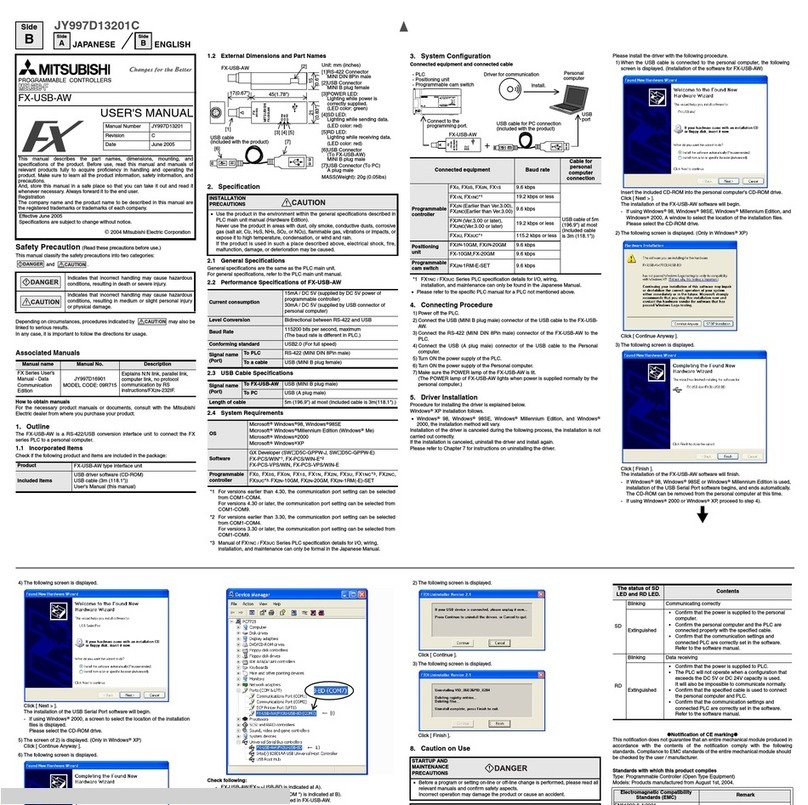
Mitsubishi Electric
Mitsubishi Electric FX-USB-AW user manual

Wilo
Wilo BM-S Installation and operating instructions
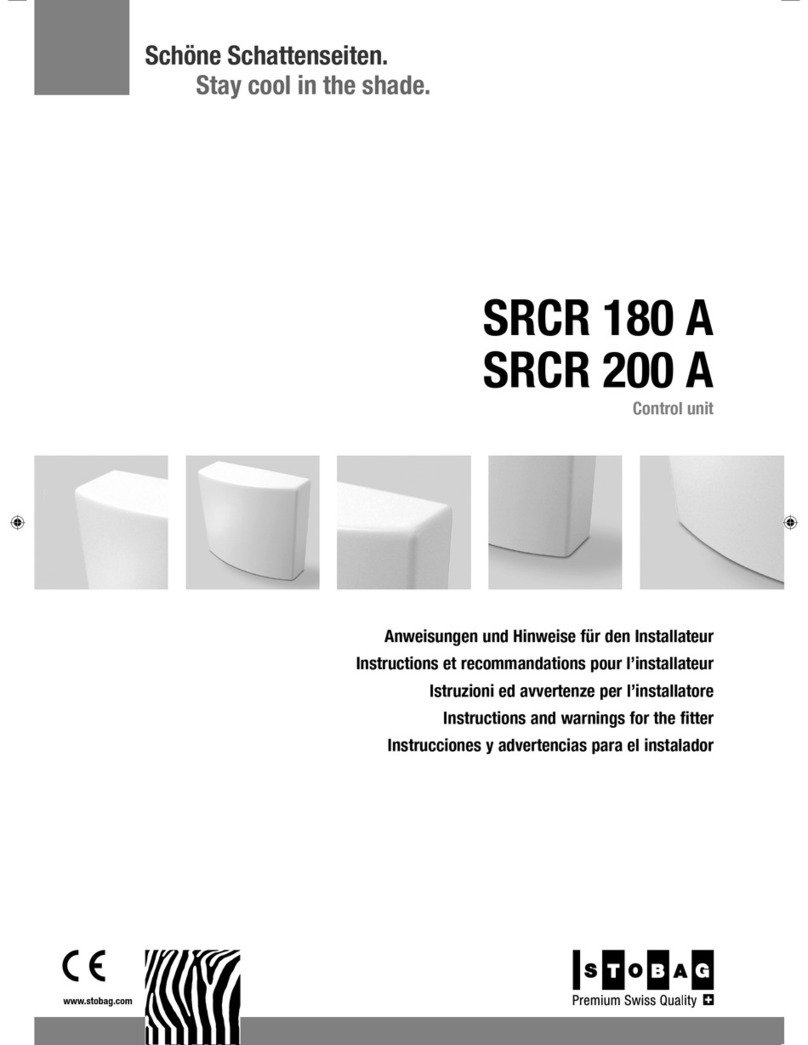
Stobag
Stobag SRCR 180 A Instructions and warnings for the fitter
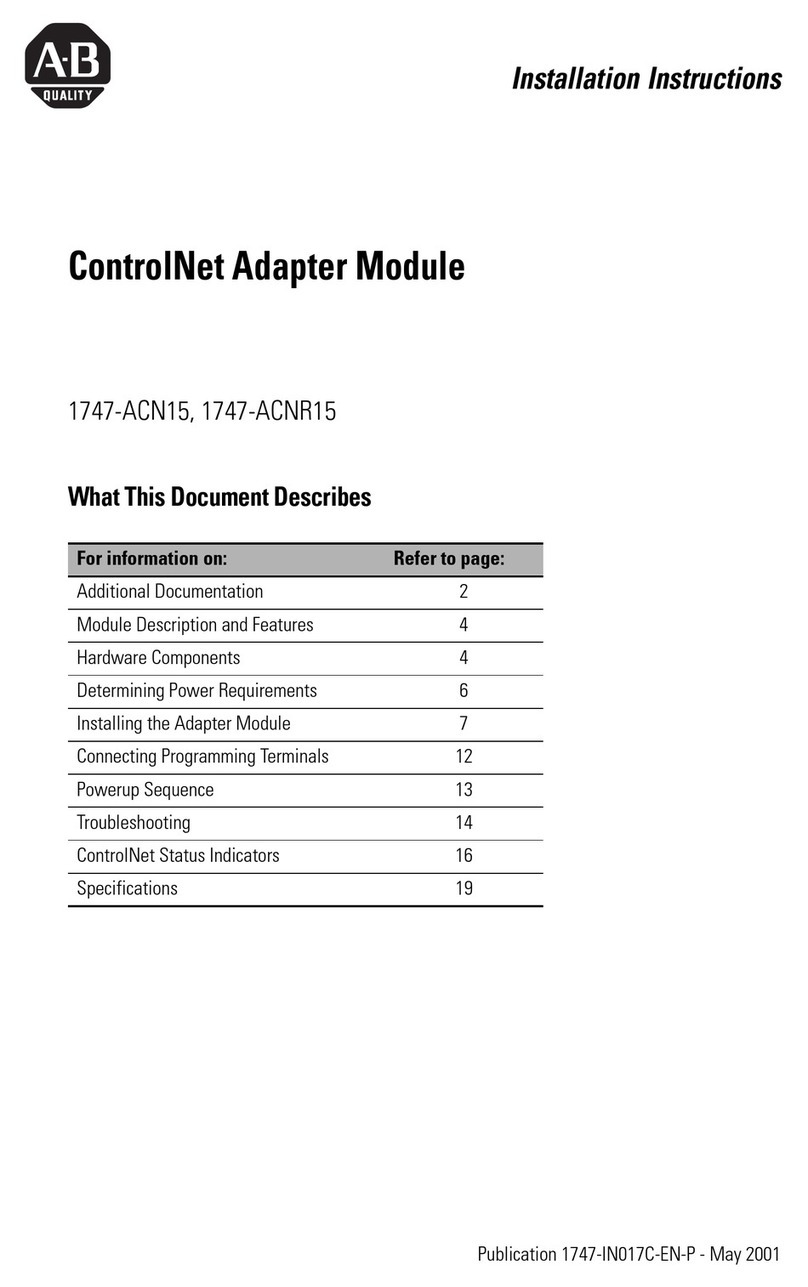
Allen-Bradley
Allen-Bradley ControlNet 1747-ACN15 installation instructions
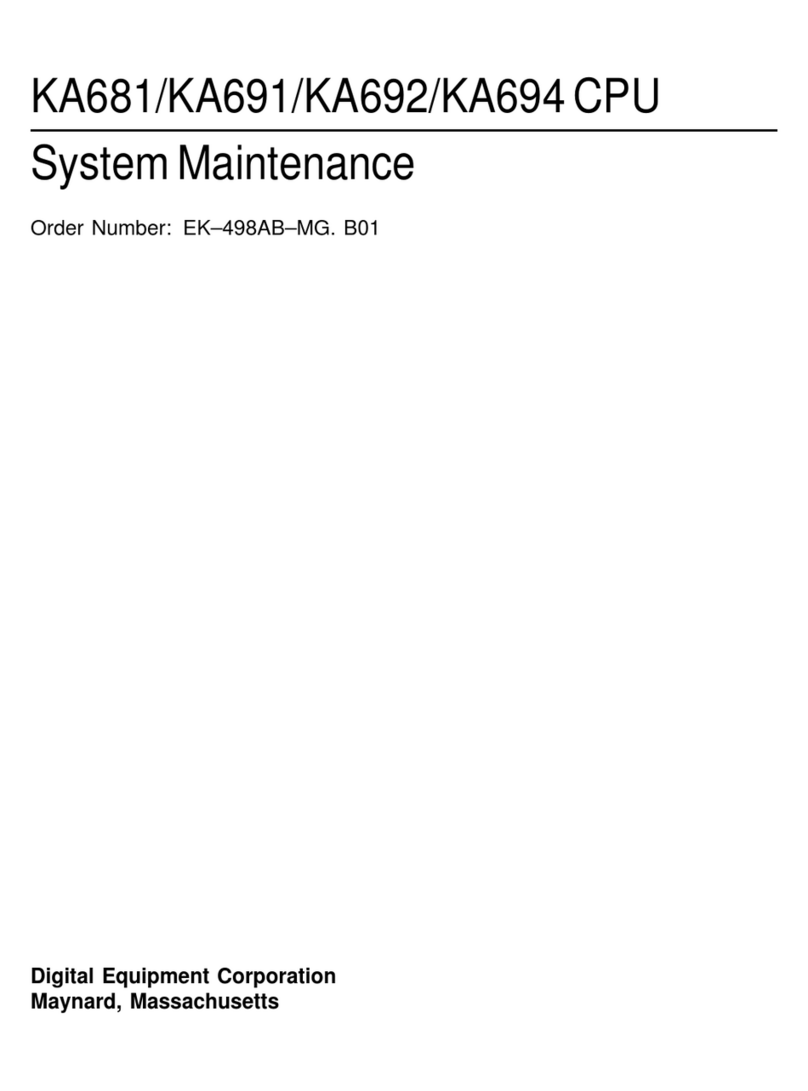
DEC
DEC KA681 System Maintenance
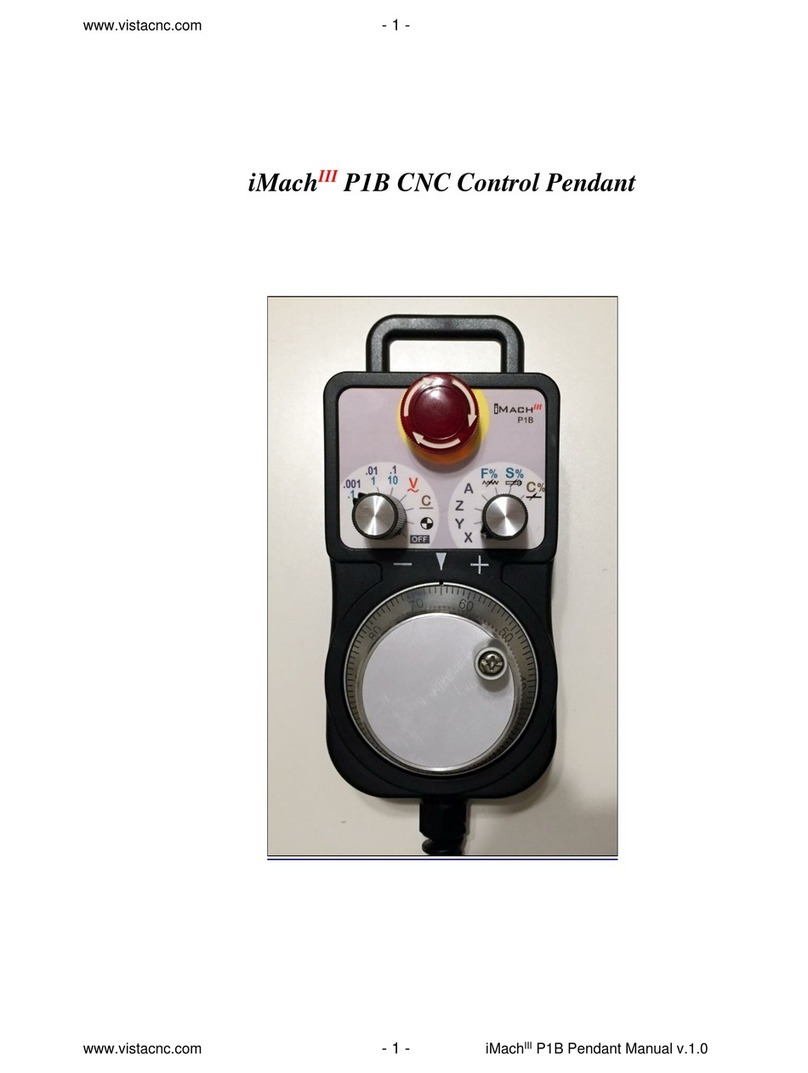
vistaCNC
vistaCNC iMachIII P1B manual
